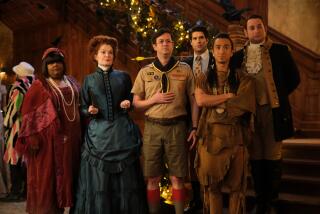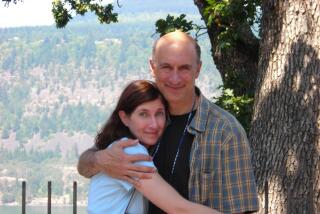The realist sees more than her eye beholds
- Share via
British novelist Hilary Mantel’s strange and compelling memoir, “Giving Up the Ghost,” spans half a century, from her early childhood in a small town on the fringes of England’s rugged Peak District to the present. But rather than being a comprehensive account of the many facets of its author’s eventful, productive and interesting life, “Giving Up the Ghost” focuses on two highly perplexing and troubling aspects of it. The first involves the spiritual realm of ghosts, fears and other shadowy presences she first sensed as a child. The second involves the very real but almost equally mysterious bodily illness that has plagued her for most of her adult life.
The book opens in late July 2000, when Mantel and her husband are planning to sell their cottage in Norfolk: “About eleven o’clock, I see a flickering on the staircase. The air is still; then it moves. I raise my head. The air is still again. I know it is my stepfather’s ghost coming down. Or, to put it in a way acceptable to most people, I ‘know’ it is my stepfather’s ghost.
“I am not perturbed. I am used to ‘seeing’ things that aren’t there. Or -- to put it in a way more acceptable to me -- I am used to seeing things that ‘aren’t there.’ ”
Mantel is not the only writer ever to have described seeing a ghost. Indeed, ghosts have a long and distinguished history in English literature, where they have often stood for whatever is beyond human experience or eludes definition, classification and explanation: “There are more things in heaven and on earth than dreamt of in your philosophy, Horatio.” Still, what are we to make of this opening page, with its direct challenge to reason, to the world as most of us know it?
Is the author a liar, out to deceive us? Or is she honest but self-deluded, perhaps even unbalanced? Or is this ghost business a kind of artistic license, a metaphor? Should we simply read her book, willingly suspending disbelief, which is what imaginative literature is supposed to induce us to do anyway? But “Giving Up the Ghost,” although literature, is not fiction. And Mantel’s opening page insists that the quotation marks should not be placed around the supernatural but around the denial of its possibility. Things that people say “aren’t there” are there for her.
Mantel provides a clue when she refers to the “phenomenological truth” of an apparition she saw, felt or sensed as a child in the garden behind her house. Insofar as we cannot finally determine whether what appears to us is something “out there” in the objective world or merely the creation or projection of our own consciousness, the founder of phenomenology, Edmund Husserl, recommended that we simply describe what we perceive without pronouncing on its reality or unreality.
Between her seventh and eighth birthdays, Mantel recalls experiencing what might be called an intimation of evil as an active power in the world: “Something makes me look up.... My eyes are drawn to a spot ... some fifty yards away, among coarse grass, weeds, and bracken. I can’t see anything ... except the faintest movement, a ripple, a disturbance of the air. I can sense a spiral, a lazy buzzing swirl; like flies, but it is not flies. There is nothing to see. There is nothing to smell. There is nothing to hear. But its motion, its insolent shift, makes my stomach heave.... The air stirs around it, invisibly. I am cold, and rinsed by nausea.... Within the space of a thought it is inside me, and has set up a sick resonance within my bones and in all the cavities of my body.”
Mantel was born in 1952 to a Roman Catholic family of Irish descent living in what Victorians might have called a humble village in chilly northern England. She was clearly a sensitive child in every conceivable sense of that word. In the pages of her memoir, we see a child whose senses are literally hypersensitive to her surroundings. She is a fierce little girl with soft pale yellow hair, delicate in appearance, health and sensibility; prone to fevers, rashes and all manner of ailments. Yet she is full of spirit, quick to feel outrage, passion, fear and anger, and quick to defend herself with a well-aimed punch. Her ambition is to become a knight-errant. It is some years before she grasps the fact that she is not going to turn into a boy.
Her active imagination also is informed by the Catholicism instilled at her school. The upward mobility that comes with her mother’s second husband, a Protestant, lands them in a prettier village and more modern house when Hilary turns 11. She displays great academic promise on her exams and, rather to her own surprise, gets to pursue her education at a higher-echelon convent school, where she flourishes.
Oddly, Mantel does not dwell overmuch on what many a memoirist might have made the centerpiece: The new man in her mother’s life moved in with the family while Hilary’s father was still in their home, during which time he was relegated to marginal status before finally disappearing from their lives.
“As the decade wore on and my family became established in its new life, I felt like a death’s-head at the feast. Henry, my father, might as well have been dead; except that the dead were more discussed. Perhaps my mannerisms recalled him, as an unwelcome ghost by the fire....”
Some years later, when she is studying for a law degree, Mantel is racked by severe bodily pains. Her doctor is baffled. The problem may be psychosomatic, she is told. She hopefully anticipates an opportunity to get to the psychological root of her affliction. Instead, she’s pumped full of various psychotropic drugs that actually make her feel and act crazy. Eventually, putting her analytical mind and research skills to work, she discovers the correct diagnosis for her pains -- endometriosis. But this, alas, leads to an operation ending the possibility of her bearing children and to various hormonal drug treatments that wreak havoc on her well-being. Indeed, the second part of her memoir presents an unsettling account of the extent to which brute physical forces can shape our lives against our wills.
Mantel’s literary career reveals, amid much else, two polarities that, as William Blake might have said, are fruitful contrarieties. On one hand, she is dogged in pursuit of facts and fierce in her commitment to truth. Her historical novel on the French Revolution, “A Place of Greater Safety,” involved years of meticulous research. Her novels “A Change of Climate” and “Eight Months on Ghazzah Street” provide vivid portraits of southern Africa and Saudi Arabia. Her sharp mind and discerning eye also are evident in her work as a critic and book reviewer. Yet she also champions things that cannot -- or will not -- be explained, rationalized or dissected, whether it is the mysterious alchemist of her novel “Fludd” or the doomed, outsized, dreamy monster-hero of “The Giant, O’Brien.”
One might call her a realist in the broader sense: a writer with an aversion to ignoring the darker, less explicable aspects of experience. And these are the heart and soul of “Giving Up the Ghost.”
More to Read
Sign up for our Book Club newsletter
Get the latest news, events and more from the Los Angeles Times Book Club, and help us get L.A. reading and talking.
You may occasionally receive promotional content from the Los Angeles Times.







